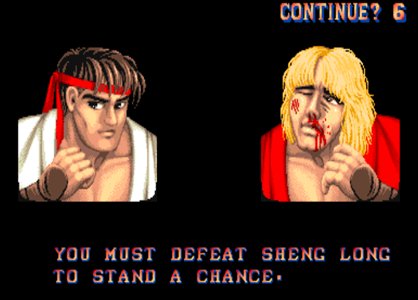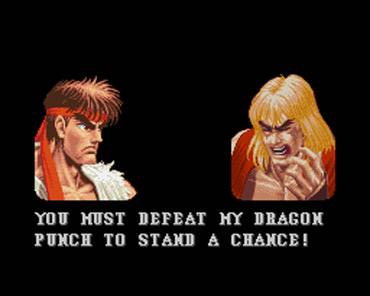The Legend of Sheng Long

The image above is a screenshot from the iconic 1991 arcade game Street Fighter II. In the game, players control a character in a tournament of street fights (imagine that) to crown the world’s best. Two of the available characters are pictured above. On the left is Ryu, a Japanese martial arts master. On the right, bruised and bloodied is Ken, his American former training partner. Ryu, having defeated Ken, taunts his fallen opponent with some half-hearted advice: “You must defeat Sheng Long to have a chance.”
Who is Sheng Long, though? Well, that’s complicated.
If you’re familiar with the Street Fighter series, you already know the fighters can punch and kick and block, sure, but you’re never going to win that way. Each fighter has a series of special moves which are more powerful and require some magic manipulation of the joystick and buttons. (Personally, I was always bad at them and used E. Honda because one of his special moves — a series of fast slaps which left your opponent unable to move due to the speed — simply required the player to rapidly tap the “punch” button. Easy move plus relatively high chance of success was the only strategy I was able to execute.) Ryu had a few such moves. There was the hadoken, which shot a ball of energy at the other guy; the tatsukaki, a hurricane kick where he’d spin at his opponent, kicking the whole time; and of particular importance to Sheng Long, the shoryuken, or rising dragon, which was an uppercut mixed with a jump. (Ken had the same moves but didn’t look like a karate master-slash-ninja, which is why people rarely used Ken.)
The problem with these moves, from the perspective of anyone interested in Sheng Long, is that the Street Fighter series is Japanese in origin. The words for all these special moves — and for the rest of the game, for that matter — had to be translated from Japanese to English. Ryu’s message to Ken (and anyone else he defeated) references the shoryuken, and is supposed to read “if you cannot overcome the Rising Dragon Punch, you cannot win!” For some reason, though, the translator working on Ryu’s post-victory taunt read the Japanese characters for “Rising Dragon Punch” as a proper noun having no English definition. Instead, the translator used a Chinese system for transliterating the characters into English, and the word “shoryuken” was transliterated into “Sheng Long” — and accidentally created the character. Sheng Long, unfortunately, didn’t actually exist, so one could follow through on Ryu’s advice.
Many fans noticed the message though — Ryu was one of the first fighters you came across, and many players failed to defeat him the first time (or in my case, the first 100 times), so the “defeat Sheng Long” objective burned its way into gaming culture. Unfortunately, the gamers who noticed the problem didn’t necessarily have any reason for knowing it was a translation error. Instead, the community had created a series of explanations for whom Sheng Long was, with the most popular one placing him as Ryu’s and Ken’s karate master.
The mystery got out of hand when in 1992, gaming magazine EGM published an article explaining how to unlock the non-existent character. That explanation, seen here, was a task of incredible difficulty to the point of nearing impossible, and wouldn’t have worked anyway, as the article was a clear April Fools’ joke — if you were an American, at least. A number of non-US publications ran EGM’s “findings” and rewrote the explanation as fact, leading to even more confusion.

Capcom, the owners of the Street Fighter franchise, fixed the error for the Super Nintendo version of the game, as seen above. The company has also acknowledged the legend of Sheng Long at various times over the last two decades, including three mentions of him in the 1995 game Street Fighter: The Movie. (Yes, “Street Fighter: The Movie” is a video game and not a movie.) But the character has never appeared in a Street Fighter game, and Capcom has stated that will remain the case.
Bonus Fact: There are three boss characters in Street Fighter II — M. Bison, Vega, and Balrog. In the English-speaking world, Balrog is a boxer, Vega is a wielding Spaniard, and M. Bison is a red-clad would-be dictator. But that wasn’t how the game was originally designed. The boxer character was modeled after Mike Tyson and was supposed to be called M. Bison, but Capcom feared legal action, so they switched the names around. In the Japanese version of the game, though, the originally-intended names stuck. The character Americans call M. Bison is Balrog, Balrog is Vega, and Vega is M. Bison. Confused? Here’s a chart.
From the Archives: A Festivus for the Peruvians: Street fighters.
Related: Street Fighter Monopoly.
